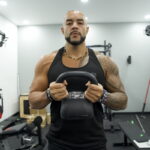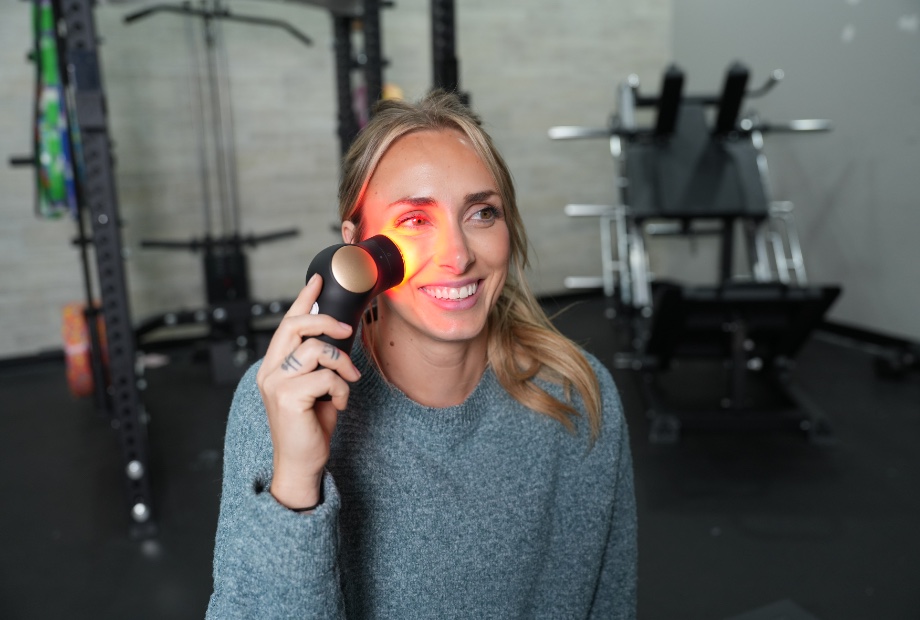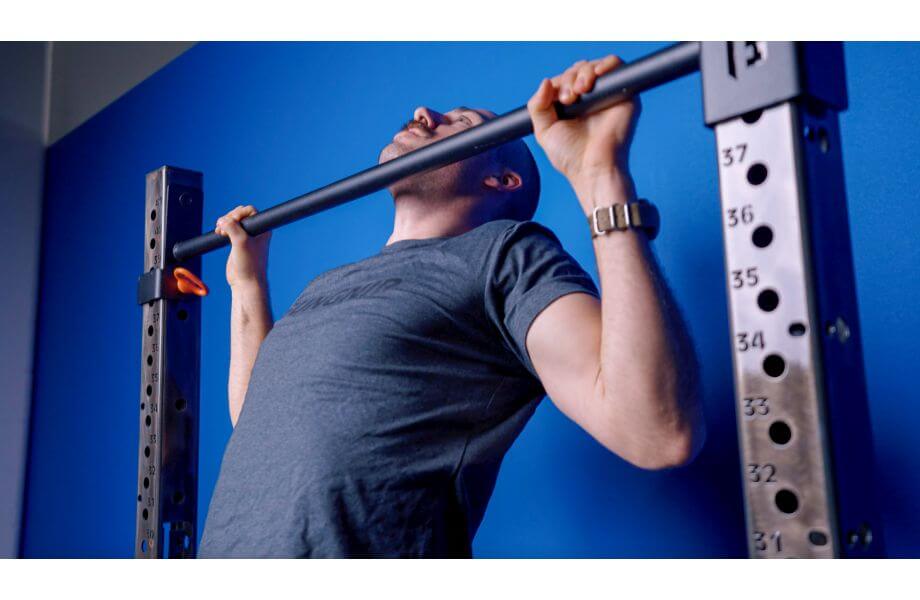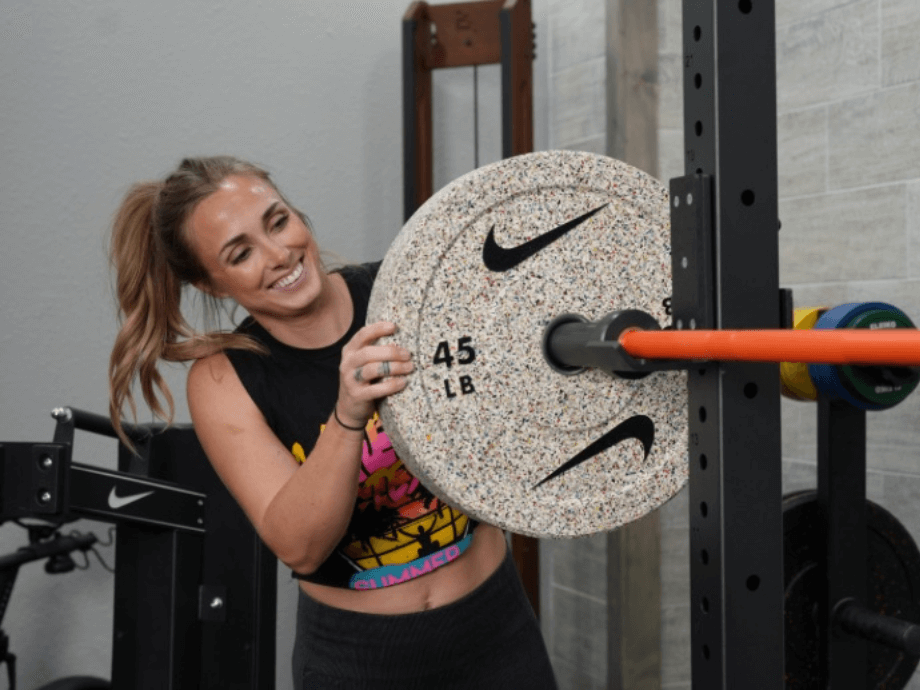When it comes to health and longevity, we’re always looking for that extra edge that’ll allow us to look and feel our best as long as possible. While resistance training, eating nutritious foods, and getting quality sleep should be considered staples in any wellness routine, there’s room for debate about other practices that may or may not support a healthy mind and body.
In a tech-driven world where we rely on devices like fitness trackers, heart rate monitors, and massage guns, red light therapy (RLT) continues to gain traction for everything from skin conditions to muscle recovery to pain relief. But does science support its efficacy? Or is RLT just another biohacking fad that’s infiltrated the health and fitness industry?
RELATED: What Is Biohacking?
As a certified personal trainer (CPT) who’s tried different recovery techniques like saunas, ice baths, and good ol’ foam rolling, I’ll shed light on research-backed red light therapy benefits so you can decide whether to flip the switch and become a supporter of this innovative light treatment. Whether you’re looking to promote hair growth, enhance your skin health, or speed up the wound healing process, RLT could be a game-changing addition to your wellness routine.
What Is Red Light Therapy?
Red light therapy (RLT) is a non-invasive treatment that uses low-level wavelengths of red and near-infrared light to facilitate healing and produce more energy within your cells. It also goes by several other names, including:
- Photobiomodulation (PBM)
- Photonic stimulation
- Biostimulation
- Low-level laser therapy (LLLT)
- Low-power laser therapy (LPLT)
This form of phototherapy was developed by NASA1 in the late ‘90s when engineer Ron Ignatius worked with the Wisconsin Center for Space Automation and Robotics (WSCAR) to complete a light-emitting diode (LED) plant-growth unit to help grow potatoes in space. While it successfully drove photosynthesis, NASA scientists also discovered that LED wavelengths offered potential health benefits for wound healing, bone density, and muscle atrophy.
Following decades of research and experimentation, RLT stands out as an attractive option in the medical and wellness fields. Considered safe with minimal side effects, this painless procedure is part of a light therapy market that’s valued at nearly $750 million2 in 2024. You can find red light devices in spas, doctor’s offices, weight-loss centers, and dermatology clinics, and there are even ones for home use.
RELATED: Best Red Light Therapy
How Does Red Light Therapy Work?
Red light therapy works by repetitively delivering specific wavelengths of red or near-infrared light to your body’s cells. According to a 2013 study3, low wavelengths of red light penetrate the skin between 1 and 2 millimeters. These waves are absorbed by light-absorbing molecules called chromophores. This process increases activity in your mitochondria (the powerhouse of your cells), resulting in an increase in adenosine triphosphate (ATP) production. For anyone who likes lifting weights or performing intense activities, more ATP means more energy to crush your workouts.
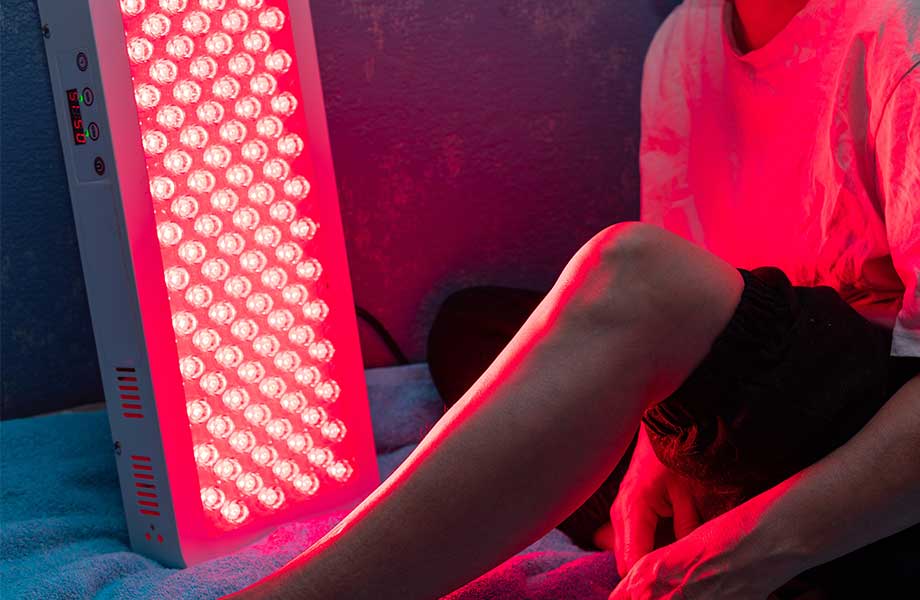
The effectiveness of red light therapy rests on its ability to stimulate not only ATP production but also increase blood flow, reduce inflammation, and even reduce oxidative stress. Unlike the ultraviolet rays used in tanning booths, which can cause harm even during short-term exposure, red light is considered safe and beneficial for long-term use as long as you follow recommended guidelines and best practices.
RELATED: Do Massage Guns Work?
Red Light Therapy Benefits
Although it may seem like just another health and fitness fad, red light therapy offers a slew of potential benefits. From anti-aging to wound healing to muscle recovery, let’s explore the science-backed reasons to add RLT to your recovery routine.
1. Can Help Reduce Inflammation
Chronic inflammation can lead to joint stiffness and muscle pain. While you can support a healthy inflammation response by consuming foods like turmeric, ginger, and leafy greens, red light therapy may offer an additional boost.
According to a 2017 study4, one of the most reproducible effects of RLT is an overall reduction in inflammation. Specifically, this form of therapy has been shown to reduce inflammation in the brain, abdominal fat, wounds, lungs, and spinal cord.
RELATED: Best Turmeric Supplement
2. May Accelerate Wound Healing
As NASA scientists discovered in the ‘90s, red light therapy can aid in wound healing by stimulating the activity of fibroblasts5—cells that contribute to the formation of connective tissues. According to a 2023 study6, low-power laser light therapy at a wavelength of 661 nanometers (nm) activated the migration and proliferation of reactive oxygen species (ROS) production in the in vitro model used. This provided evidence that it could accelerate wound healing in vivo—which refers to in a living organism.
3. Can Help Reduce Fine Lines and Wrinkles
One of the most popular uses of red light therapy is for its potential anti-aging effects. A 2020 study7 in the Journal of Drugs in Dermatology suggests that LED phototherapy can be an effective treatment for aging skin. According to the study, RLT can help with skin rejuvenation by stimulating fibroblasts to secrete collagen proteins, which play a critical role in maintaining the structural integrity of not only your skin but also hair, nails, and other tissues.
By improving blood flow and ramping up elastin8 and collagen production, RLT can help reduce the appearance of fine lines and wrinkles. This can result in smoother, healthier skin—and who doesn’t want that?
RELATED: Benefits of Collagen Protein Powder
4. Can Help Treat Certain Skin Conditions
Red light therapy has proven effective in treating various skin conditions, including psoriasis, eczema, and acne. According to a 2018 study9 published in Lasers in Medical Science, people with plaque psoriasis were able to clear 60% to 100% of their skin with two RLT sessions per week for one month.

Meanwhile, red light therapy can also help keep eczema—a condition characterized by itchy, red, swollen and cracked skin—at bay. In addition to psoriasis and eczema, the Cleveland Clinic10 notes that RLT is also promoted as a treatment for rosacea and sun-damaged skin.
5. Can Promote Hair Growth
Red light therapy offers a promising solution for people struggling with hair loss or alopecia areata11—a disease that causes your immune system to attack hair follicles, resulting in hair loss. According to a 2021 study12, low-level 650-nm red light promoted the proliferation of human hair follicles in the cultured-tissue model used.
In addition, a 2021 study13 published in the Journal of Cutaneous and Aesthetic Surgery found that low-level laser therapy (LLLT) stimulates hair growth in both men and women. The researchers concluded that LLLT represents a safe, non-invasive effective treatment option for patients with androgenetic alopecia, which is one of the most common forms of this condition.
6. May Provide Pain Relief
Red light therapy can help provide relief from chronic pain conditions such as osteoarthritis and tendonitis by reducing inflammation and swelling and promoting blood flow. A 2022 study14 published in the European Journal of Physical Rehabilitation Medicine found that photobiomodulation therapy reduces pain intensity in non-specific knee pain, lower back pain, fibromyalgia, and other pain-related conditions. This treatment option can provide relief for both acute and chronic musculoskeletal conditions.
RELATED: Knee Pain From Elliptical Training
7. Can Help With Muscle Recovery
Resistance training results in micro-tears in your muscle fibers. However, you can use red light therapy to facilitate faster recovery so you can crush your next workout. Promoting better blood flow and reducing inflammation can ensure oxygen and nutrients get delivered to damaged tissues.
Interestingly, a 2017 review15 of randomized controlled trials and case studies found that red and near-infrared light can stimulate, heal, and regenerate damaged muscle tissue. In fact, it showed that light therapy can increase muscle mass gained after training and decrease oxidative stress.
RELATED: Best Muscle Recovery Tools
Red Light Therapy Applications: How to Get Started
Now that you know about the benefits of red light therapy, the obvious question is: How do you actually incorporate it into your routine? Luckily, red light therapy can be administered through various devices, such as:
- Handheld devices: Used to treat small, localized areas, including the face, joints, or specific muscle groups.
- Panel devices: Larger panels that cover more extensive areas, often mounted on a stand or wall.
- Face masks: Masks equipped with red and near-infrared LEDs, used for reducing wrinkles and treating skin conditions.
- Light therapy beds: Similar to tanning beds but equipped with red/near-infrared LEDs
- Caps and helmets: Designed to be worn on your head to promote hair growth
RELATED: Best Infrared Sauna
To begin implementing red light therapy in your daily life, it’s essential to choose the right at-home device. LED light panels and wands offer convenience and accessibility and can be used to target specific areas of the body. However, it’s important to follow the manufacturer’s guidelines and avoid overuse to prevent any negative side effects.
GGR Senior Staff Writer and Olympian weightlifter Caine Wilkes used a red light therapy wrap to help recover from a knee injury. While he also got a platelet-rich plasma (PRP) injection, he credits at least part of his recovery to consistently using the RLT wrap each night for two months and intermittently since then.
“From my understanding, you see the most benefit from it when you’re consistently using it,” Caine explains.
How exactly should you go about implementing RLT? A typical session lasts about 10 to 20 minutes. Always remember to protect your eyes and consult with a dermatologist or healthcare professional before starting any new treatment. This can help ensure you experience the benefits of red light therapy without any adverse reactions.
Red Light Therapy Benefits: Final Thoughts
You can use red light therapy devices as a non-invasive treatment option for a variety of health conditions, including skin rejuvenation, wound healing, pain relief, and hair growth. Supported by scientific research and clinical studies, RLT can be a safe, effective way to enhance your health and wellness routine without investing a ton of time or effort.
So, whether you’re searching for another muscle recovery solution or seeking relief from chronic pain or inflammation, give the green light to red light therapy.
Red Light Therapy Benefits: FAQs
Who should not have LED light therapy?
People who are pregnant, individuals with sensitivities to light, and anyone taking photosensitizing medications shouldn’t use LED light therapy without consulting a doctor or healthcare professional.
Are there any potential side effects of red light therapy?
Potential red light therapy side effects include redness, tightness, or irritation in the treated area.
How is red light therapy different from blue light therapy?
While red light therapy targets deeper skin layers, blue light therapy, also referred to as photodynamic therapy, helps treat superficial skin conditions like acne, psoriasis, rosacea, eczema, and skin cancer.
How long does it take to see results from red light therapy?
Many individuals experience noticeable improvements in skin tone, texture, and pain relief after several weeks of consistent red light therapy.
How often should you do red light therapy?
You can do red light therapy three to five times per week, depending on the condition being treated and the device used. Consistent treatment will provide the best results.
Can you overdo red light therapy?
Yes, too much red light therapy may cause skin irritation, redness, and discomfort. Follow recommended guidelines and suggested treatment times to avoid negative side effects.
References
- NASA research illuminates medical uses of light | NASA spinoff. (n.d.-b). https://spinoff.nasa.gov/NASA-Research-Illuminates-Medical-Uses-of-Light
- Light Therapy Market Size & Share. (n.d.). https://finance.yahoo.com/news/light-therapy-market-size-share-230000359.html
- Avci, P., Gupta, A., Sadasivam, M., Vecchio, D., Pam, Z., Pam, N., & Hamblin, M. R. (2013). Low-level laser (light) therapy (LLLT) in skin: stimulating, healing, restoring. Seminars in cutaneous medicine and surgery, 32(1), 41–52.
- Hamblin, M. R. (2017). Mechanisms and applications of the anti-inflammatory effects of photobiomodulation. AIMS Biophysics, 4(3), 337–361. https://doi.org/10.3934/biophy.2017.3.337
- Fibroblast. (n.d.). Genome.gov. https://www.genome.gov/genetics-glossary/Fibroblast
- Giannakopoulos, E., Katopodi, A., Rallis, M., Politopoulos, K., & Alexandratou, E. (2022). The effects of low power laser light at 661 nm on wound healing in a scratch assay fibroblast model. Lasers in Medical Science, 38(1). https://doi.org/10.1007/s10103-022-03670-5
- Huang, A., Nguyen, J., Ho, D., & Jagdeo, J. (2020). Light emitting diode phototherapy for skin aging. Journal of Drugs in Dermatology, 19(4), 359–364. https://doi.org/10.36849/jdd.2020.4711
- Wang, K., Meng, X., & Guo, Z. (2021). Elastin structure, synthesis, regulatory mechanism and relationship with cardiovascular diseases. Frontiers in Cell and Developmental Biology, 9. https://doi.org/10.3389/fcell.2021.596702
- Zhang, P., & Wu, M. X. (2017). A clinical review of phototherapy for psoriasis. Lasers in Medical Science, 33(1), 173–180. https://doi.org/10.1007/s10103-017-2360-1
- Professional, C. C. M. (n.d.). Red Light Therapy. Cleveland Clinic. https://my.clevelandclinic.org/health/articles/22114-red-light-therapy
- Branch, N. S. C. a. O. (2023, July 27). Alopecia areata. National Institute of Arthritis and Musculoskeletal and Skin Diseases. https://www.niams.nih.gov/health-topics/alopecia-areata
- Yang, K., Tang, Y., Ma, Y., Liu, Q., Huang, Y., Zhang, Y., Shi, X., Zhang, L., Zhang, Y., Wang, J., Zhu, Y., Liu, W., Tan, Y., Lin, J., & Wu, W. (2021). Hair Growth Promoting Effects of 650 nm Red Light Stimulation on Human Hair Follicles and Study of Its Mechanisms via RNA Sequencing Transcriptome Analysis. Annals of Dermatology/Annals of Dermatology, 33(6), 553. https://doi.org/10.5021/ad.2021.33.6.553
- Pillai, J., & Mysore, V. (2021). Role of low-level light therapy (LLLT) in androgenetic alopecia. Journal of Cutaneous and Aesthetic Surgery, 14(4), 385. https://doi.org/10.4103/jcas.jcas_218_20
- De Oliveira, M. F., Johnson, D. S., Demchak, T., Tomazoni, S. S., & Leal-Junior, E. C. (2022). Low-intensity LASER and LED (photobiomodulation therapy) for pain control of the most common musculoskeletal conditions. European Journal of Physical and Rehabilitation Medicine, 58(2). https://doi.org/10.23736/s1973-9087.21.07236-1
- Ferraresi, C., Huang, Y., & Hamblin, M. R. (2016). Photobiomodulation in human muscle tissue: an advantage in sports performance? Journal of Biophotonics, 9(11–12), 1273–1299. https://doi.org/10.1002/jbio.201600176

